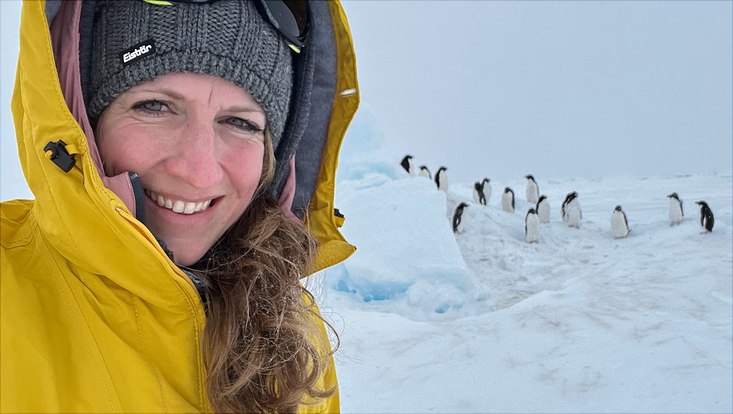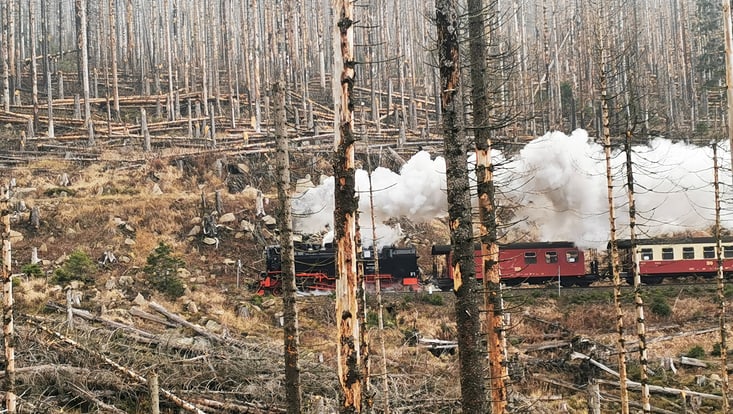Antarctic sea ice grows from the top – thanks to snow
18 November 2024, by Stefanie Arndt

Photo: Stefanie Arndt/AWI
Ever since I was 18, when I saw a poster that said “Polar Meteorology” during an open house day at the University of Hamburg, the Antarctic has been my greatest dream. From then on, I did everything I could to make that dream come true. Today, as a member of the University of Hamburg’s Center for Earth System Research and Sustainability (CEN) and a researcher for the Alfred Wegener Institute (AWI), I’m investigating the connections between ice and snow in the Antarctic’s Weddell Sea.

In contrast to the High North, in Antarctic sea ice is covered with snow year-round. This insulating layer plays an important part in the ice’s energy budget; it determines how much thermal energy is absorbed or reflected – and how much sea ice forms. After all, ice doesn’t merely grow when seawater freezes; the snow atop it can also turn into ice. In order to find out how this works, I regularly visit the region. The AWI operates a major research station at the massive bay of the Weddell Sea. The sea itself has an area of 2.8 million km2. We’ve deployed specially designed buoys in its sea ice, which measure the current snowfall. In addition, I gather samples.
Why? Because not all snow is created equal: a bit like tree rings, snow has multiple layers, which allow me to determine what the prevalent climatic conditions were like in my survey area over the past several months. Some snow is fluffier, some denser, sometimes it contains tiny ice crystals, and sometimes it’s frozen solid. Investigating this aspect in detail helps me understand how the sea ice of the Weddell Sea grows.
What does snow have to do with ice formation? We’ve already confirmed two essential processes: when sunlight makes the snow start to melt, the meltwater trickles down through the remaining layers and freezes when temperatures drop again. This produces a rhythm of thawing and freezing, forming layered ice, also called aufeis (German for “ice on top.”). Conversely, additional moisture can come from the ocean: if there is enough snow, it can weigh down the ice, causing it to ride lower in the water – to the point where seawater laps up onto its surface and mixes with the snow. When the mixture freezes, it is referred to as “snow-ice.” The two types of ice differ in their salinity.
Accordingly, the ice of the Weddell Sea doesn’t just grow from below, when seawater freezes, but also and especially through the snow atop it. By combining our observational data with computer models, my team and I were able to show that the latter type, the snow-ice, especially forms in the eastern Weddell Sea. Later, the large floes are transported northwest by the ocean currents and cold winds of the Antarctic. As a result, the ice covers a larger and larger area, a bit like spreading out the dough for a pizza crust. In contrast, we chiefly found aufeis farther to the north, where it’s warm enough for the snow to melt during the summer months.
As you can see, how the Antarctic ice grows is a complex topic. It doesn’t just involve the freezing of seawater; rather, there are a range of different processes, in which snow plays a central part. And in the era of climate change, this raises the question of how these processes will evolve: will there be more precipitation in the form of snow, which then becomes ice? Or will the climate warm to such an extent that, in the long term, there will no longer be snow cover year-round in the Antarctic, both processes will grind to a halt, and the ice of the Weddell Sea will dwindle?
More information
Stefanie Arndt is sea ice physicist and expert on Antarctic snow. She researches the sea ice of the Antarctic Weddell Sea for the Alfred Wegener Institute and at the Centre for Earth System Research at the University of Hamburg.
Newspaper: This article was first published as a guest article in the Hamburger Abendblatt as part of a monthly series on climate research. Find all articles of the series here. Find all articles of the series here.


